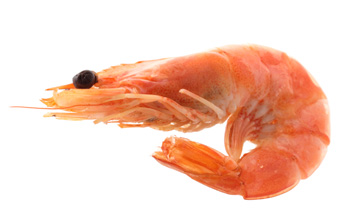
Shrimp Shells to give Salmon Healthy Colour
8.5 million tons of food scraps are annually taken directly to the incineration. Researchers from the Faculty of Engineering work at utilizing the waste for an export-adventure. For example, shrimp shells are to be converted into a valuable red colour, which can provide natural colour for salmon and may be able to combat wrinkles.
The vast majority of salmon we pull ashore from the supermarket refrigerator are farmed Norwegian salmon which are painted orange-red with a synthetic colouring. In the wild salmon eat shrimp and thereby receive the beautiful orange-red colour, we know as the salmon-colour. In captivity salmon flesh grey, because they do not feed on shrimp, but consumers will not sink teeth into a grey salmon, which is why breeders add synthetic colouring to the feed.
- The natural pink colour we find in shrimps is very expensive. It costs approximately 11,000-23,000 kroner per kilo. Therefore, we’re now trying to find a way to separate the natural colour from shrimp shells, which the fish factories simply take to the incineration, explains Associate Professor Xavier Fretté from the Institute of Chemistry, Biotechnology and Environmental Engineering.
Colourants give fewer wrinkles
The red colour from the shrimp shells is not only used to give the salmon a natural and healthy tan, but the colorant called astaxanthin is also a popular ingredient in the beauty industry and in health food. Some researchers even proclaim astaxanthin to be a wonder drug because it is one of nature’s most powerful antioxidants.
- The shrimp shells can be a lucrative business and a lucrative export market. Making use of our resources can plant Denmark in new markets, and shrimp shells is today just run for combustion, says Xavier Fretté.
Fish factory sees big business
PhD student from Iran, Behnaz Razi Parjikolaei has set aside three years to find the correct way to separate the substances. She leads blended shrimp shells through various membranes which act as a sieve. The aim is to find the right membrane that can capture the colours, vitamins, and proteins from the shrimp shells.
- I’ve been working for 18 months now, and I’m not quite there yet. It’s important to find a method that is efficient and green, so companies easily and without causing damage to the environment, can separate the precious colorant astaxanthin. The utilization of our resources can plant Denmark in new markets, says Behnaz Razi Parjikolaei who is working with Launis Fiskekonserves A/S from Aalbæk in North Jutland.
The project plays into a larger effort in which researchers work hard to wring out nutrients, vitamins and other beneficial substances of yet unexploited resources such as the sea and garbage.
For more information contact
Associate Professor Xavier Fretté at the Institute of Chemical Engineering, Biotechnology and Environmental Technology at 6550 7337 / xafr@kbm.sdu.dk